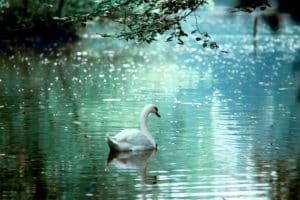When we think of blight, we think of the horrifying, impersonal, creeping stuff of decay. We think of fields of dead crops, forests of dead trees, and human hearts incapable of compassion. Blight is insistent, a mindless force of badassery that’s hard to counter because it has no face and no consciousness. It can lurk in invisibility and grow from next to nothing into a rot that covers everything. While the literal definition of blight is a fungus that causes disease and decay in a living organism, we often think of any fungus as a blight, even those that only feed on already-dead matter. More poetically, a blight is anything that damages, destroys, or spoils. The way humans persist in knowingly fucking up the only planet we have, for the sake of a few oil dollars, is one example of an abstract blight. In fiction, blight is a convenient enemy, frighteningly impersonal and pervasive.
As a scientist who has a PhD in biology, with a more-fun-than-it-sounds specialization in the ecology of terrestrial decomposer fungi, I’m intimately familiar with furry white and green molds, slimy yellow and pink yeasts, and the quirks of their molecular genetics. During my doctoral studies, I attended a department meeting that involved tossing a plush toy shaped like a yeast cell from one person to the next. Each PhD student who caught the yeast cell had to describe their research in a single sentence, in the style of a movie’s logline. When it was my turn to grasp the fuzzy fabric fungus, I said, “Fungi are the masters of the global carbon cycle.”
Why would we think of mushrooms, mycelia, and molds as the mastermind behind the movement of carbon—the basis of all living things—between Earth and sky? And what does that have to do with blight as a concept that haunts the balance between life and death?
The answer lies in a feat fungi can only perform by working together in a community, never when acting as a lone mushroom or mold. I came to the PhD program not cleaving to any particular organism. Some people are enamored of the biology of butterflies or the ecology of estuaries; I wanted only to explore a big-picture question that required a marriage of evolutionary genetics with ecology. I found it in the study of decomposer fungi communities.
These communities break down dead plant matter. They’re the reason the land isn’t stacked high with millennia’s worth of fallen tree trunks. They evolved the ability to break down and derive sustenance from plant stuff on the heels of the advent of large, woody land plants. That’s also why the Earth’s fossil fuel stores cannot be expected to regenerate, even on the unimaginable timescales required to form coal, oil, and natural gas: they formed at a time when the decomposer fungi equipped to demolish newly evolved land plants’ most recalcitrant tissues did not yet exist. Fungi release some of the carbon in plant tissues to the atmosphere, and they store some of it in the soil, in their own tissues. Unlike humanity’s massive, rapid, short-term release of carbon from fossil fuels into the atmosphere, fungi regulate carbon’s flow between the biosphere and atmosphere in a balanced way and at a sustainable pace. Researchers are even looking into ways to harness fungal and bacterial activity to store more carbon in soils to offset humanity’s excess release of carbon.
So, when we say, “Ew, gross!” to the white filaments that devour leftover food, we’re repulsed by the same stuff that’s responsible for the fact the Earth isn’t covered with mountains of undecomposed plant matter from the last 200 million years. When we grit our teeth in disgust at the green fuzz eating into an orange that’s past its prime, we’re rejecting the source of penicillin. The creeping blight that overtakes strawberries left too long before eating, and the thing that kills the potatoes in your garden, are part of the same primal force that controls the global carbon cycle. Without it, the world as we know it would not exist. This knowledge sheds new light on the role of blight in fiction: it suggests upbeat story resolutions that arise from unlikely shadows, and fatal consequences when would-be heroes vanquish the wrong foe. Story is a place where we have space to explore things that are not as they seem, accept contradictory truths that coexist in layers, and tear down facile assumptions.
#
Before I started research on microbes, I was not prepared for the degree of caution required for culturing fungi. First, to perform inoculations (additions of fungal cells to sugar-rich medium in a Petri dish to grow colonies of selected species), it was necessary to work in a cabinet designed to prevent invisible microorganisms from entering the workspace on air currents. All tools used in the procedure were sterilized in an autoclave via a 90-minute steam-and-pressure process and only removed from their sterile wrappings inside the pre-sterilized cabinet. All surfaces inside the cabinet, and the researcher’s gloved hands, had to be thoroughly doused with enough 90% ethanol solution to kill anything it touched. All these precautions aren’t foolproof; once I became well-practiced in sterile culturing techniques, I had “only” about a one-percent contamination rate. That is, in one percent of the plates I inoculated, even with the greatest of precautions, an unintended species of fungus joined the one I’d planned to grow.
Often, the intruder was an insistent, gray-green mold that seemed ever-present in the lab’s air. However, another, more interesting interloper took over once I introduced it as part of a community of terrestrial decomposers—fungi that gain their nutrients by breaking down the dead leaves, stems, and wood that fall on the forest floor. Beauveria bassiana is a decomposer of plant matter and a parasite that causes white muscardine disease in arthropods. It took over everything, spreading powdery white splotches in every plate it came near, requiring three times the caution any other species did. Without extraordinary measures, Beauveria bassiana would, like The Blob, take over the world—or at least overrun my workspace.
Acting alone, as a single organism, Beauveria bassiana is a disease. But environmental decomposer fungi communities perform their ecosystem function in concert, working together in the layer of dead plant matter at the forest floor. In ecology, we call functions that arise collectively, from a system in which all of a range of organisms play necessary roles in performing the function, emergent properties. Sure, some decomposition is performed by each of these organisms on its own. But decomposition as a critical ecosystem function—ensuring that nutrients are returned to the soil, that some carbon is stored and some is returned to the atmosphere, and that the soil is ready to give rise to the next, highly biodiverse, phase of the life cycle—cannot be performed by any one organism alone. A dozen or more species of decomposer fungi are active at any given time, and the genomes of hundreds of species are present in a gram of soil. In contrast, as we saw in the case of Beauveria bassiana, diseases are often caused by a single species. Botrytis cinerea is a gray rot that destroys horticultural crops such as grapes and strawberries. Fusarium graminearum causes creeping necrosis on corn, rice, wheat, and barley. And yet pathogenicity is not the only means by which certain sometimes-pathogenic species survive. Many of them, Beauveria bassiana and numerous species of Fusarium and Botrytis included, are also found as members of those communities whose collective emergent property is the decomposition of dead plant matter. We call such properties ecosystem services: together, these collections of fungal species perform a service vital to the ecosystem.
#
Much as Beauveria bassiana is a blight on bees and grasshoppers yet a vital member of the soil decomposer community, the extreme schemes humans get up to are forces of both great good and great harm.
Studying the microbial masters of the carbon cycle made me a natural choice to teach courses on climate change. So, to earn my PhD student stipend, I taught academic writing courses focused on the theme of climate change, and after graduation I taught courses on the feedback cycles between anthropogenic climate change and human health. It was heartbreaking to have to tell roomful after roomful of hopeful 18-year-olds that we know everything we need to know to avert excessive warming, we have the means to do it, and it could be done without individual sacrifice or significant loss of gross domestic product. We’re held back by a handful of very rich people who don’t want to become even a little less rich, people who’re unconcerned because they’ll be dead by the time the repercussions come back to bite the asses of the world’s wealthiest countries. The decision makers in these wealthy nations don’t care that the consequences are even now dogging the heels of developing nations—always to the detriment of their most marginalized citizens, those who’re already the most vulnerable. After teaching undergrad climate science classes for years, it became clear I had only one main message for these students: we know what’s happening. We know what to do about it. And the people in power won’t do it.
So what’s the real blight here? The blight is not always the blight. When it comes to climate change, the blight is greed; whereas—at least if the research on microbial carbon sequestration capability comes to fruition—literal blight could save us.
This subversion of expectations is so stark as to feel almost like a bait and switch. To look closely into blight, whether as a literal disease-causing fungus or as an abstract concept, is to discover the cold-water shock of reversal, a shock that is by turns painful and delightful. Human ingenuity is a source of global-scale destruction despite being so often cast as the hero in the stories we tell ourselves. Likewise, the creeping stuff of decay isn’t always horrifying; the most convenient villain isn’t always the true enemy. The story of blight is the story of our need to look beneath the surface and see things that aren’t immediately obvious to the eye to understand what’s really going on. This is true in life, and it’s true in the best fiction, the tales that help us understand ourselves and the world more deeply than at surface level.
A.J. Van Belle is a nonbinary biologist and writer who lives on Vancouver Island with their husband and two dogs. Two of A.J.’s 2023 stories are on the Nebula reading list, and their fiction has appeared in journals and anthologies from 2004 to the present. A member of HWA and SFWA, A.J. is an intern at the Booker Albert Literary Agency and a mentor in two novel-writing mentorship programs. They are represented by Lauren Bieker of FinePrint Literary.
Photo by Juan Martin Lopez on Unsplash






